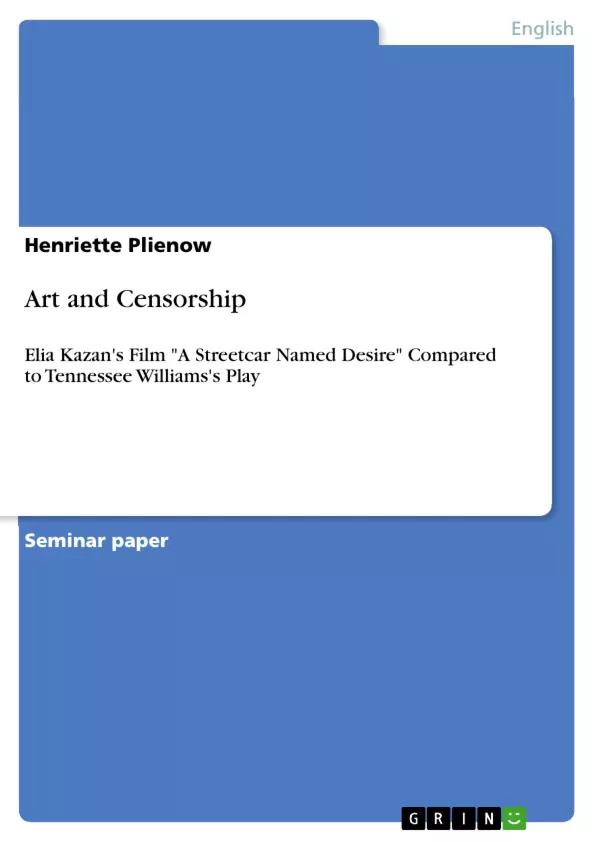This paper compares Tennessee Williams's text with Elia Kazan's movie version from 1951 as well as with the so-called 'restored version' from 1993 which contains additional scenes that had been removed by the censors in the 1951 version. It examines the differences between text and film, considering changes which were made for merely artistic respectively medium-typical reasons, as well as changes which were made due to censorship, and it analyses which effects those changes had.
Inhaltsverzeichnis (Table of Contents)
- INTRODUCTION
- THE MOVIE'S BACKGROUND: MAKING A FILM OUT OF A PLAY
- THE CAST
- DIRECTOR ELIA KAZAN
- CENSORSHIP
- THE PRODUCTION CODE ADMINISTRATION
- THE CATHOLIC LEGION OF DECENCY
- THE RESTORED 1993 VERSION
- CHANGES MADE FOR ARTISTIC REASONS
- SCENE ONE
- FURTHER OPENING UP THE SETTING
- MUSIC
- CONCLUSION
- CHANGES CAUSED BY CENSORSHIP
- STELLA'S STAIRWALK 1951 AND 1993
- ALLAN'S HOMOSEXUALITY
- STANLEY RAPES BLANCHE
- THE ENDING
- CONCLUSION: STREETCAR - A PHOTOGRAPHED PLAY?
Zielsetzung und Themenschwerpunkte (Objectives and Key Themes)
This paper examines the differences between Tennessee Williams's play *A Streetcar Named Desire* and Elia Kazan's 1951 film adaptation, as well as the 1993 restored version. It analyzes the changes made for artistic reasons, those made due to censorship, and the effects of these changes.- The reasons behind Warner Bros.' decision to produce a film version of the play.
- The process of adapting a play for the film medium, including the casting choices and Kazan's approach to directing.
- The impact of censorship on the film, including the role of the Production Code Administration and the Catholic Legion of Decency.
- The artistic choices made by Kazan in adapting the play, such as the use of music and the opening up of the setting.
- The consequences of censorship on the film, including the changes made to the plot, characters, and ending.
Zusammenfassung der Kapitel (Chapter Summaries)
The first chapter, "Introduction," outlines the reasons for comparing the play and film versions of *A Streetcar Named Desire*. The chapter discusses the popularity of the play and the financial considerations that led Warner Bros. to produce a film adaptation. It also highlights the unique challenges of adapting a play for the screen, particularly given the play's reliance on heightened realism and visual elements.
The second chapter, "The Movie's Background: Making a Film Out of a Play," explores the context of the film's production. It discusses the casting choices, Kazan's approach to directing, and the role of censorship in shaping the film. The chapter examines the Production Code Administration, the Catholic Legion of Decency, and their impact on the film.
The third chapter, "Changes Made for Artistic Reasons," discusses the artistic decisions made by Kazan in adapting the play for the screen. This includes the use of music, the opening up of the setting, and the use of close-ups to emphasize the emotional intensity of the characters' interactions.
The fourth chapter, "Changes Caused by Censorship," analyzes the changes made to the film due to censorship. This includes the removal of scenes involving Stella's stairwalk, Allan's homosexuality, and the rape of Blanche by Stanley. The chapter also examines the impact of censorship on the film's ending.
Schlüsselwörter (Keywords)
The central themes of this paper are the adaptation of a play for the screen, the influence of censorship on artistic expression, and the impact of medium-specific considerations on the interpretation of literary works. Key concepts include heightened realism, film censorship, the Production Code Administration, the Catholic Legion of Decency, and the artistic choices made by Elia Kazan in his adaptation of *A Streetcar Named Desire*.- Quote paper
- Henriette Plienow (Author), 2008, Art and Censorship, Munich, GRIN Verlag, https://www.grin.com/document/127508



